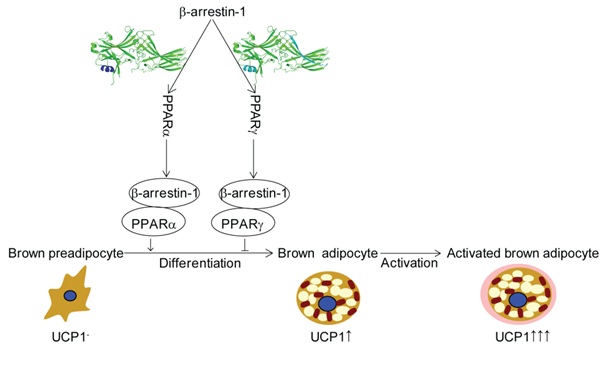
Brown adipocytes have attracted much attention because of their capacity to counteract obesity and metabolic disease. Prof. PEI Gang's lab at Institute of Biochemistry and Cell Biology (SIBCB), Shanghai Institutes for Biological Sciences (SIBS) of Chinese Academy of Sciences found that β-arrestin-1 contributes to brown adipose tissue (BAT) function. Further studies showed that β-arrestin-1 directly interacts with PPARa/γ (peroxisome proliferator-activated receptor a/γ) and modulates their transcriptional activities, providing potential regulatory pathway for BAT function. This work was published in Scientific Reports.
In contrast to white adipose tissue (WAT) which is specialized for the storage of excess energy, brown adipose tissue (BAT) contributes to energy expenditure and adaptive thermogenesis. Cold exposure leads to the stimulation of β-adrenergic receptors in brown adipocytes, resulting in the activation of oxidative phosphorylation and thermogenic activity. This process is facilitated by the increased expression of mitochondrial uncoupling protein-1 (UCP1) which uncouples substrate oxidation from Adenosine triphosphate (ATP) production so that heat is produced.
New drugs or polypeptides that increase differentiation or activity of BAT in adult humans might offer new treatments for obesity and diabetes. As major regulators in metabolism, PPARs play critical regulatory roles in regulating brown fat adipogenesis and function.
β-arrestins function mainly by binding to diverse partners and play critical roles in various signaling pathways and physiological procedures. Under the guidance of Prof. PEI Gang, ZHAO Jian and ZHOU zhaocai, graduate student WANG Congcong found that β-arrestin-1 knock-out mice shows enhanced cold tolerance and increased thermogenic gene expression.
Moreover, by biolayer interferometry assay and nuclear magnetic resonance (NMR) spectroscopy analysis, the researchers found that β-arrestin-1 directly interacts with PPARa and PPARγ through a LXXXLXXXL motif. Further mechanistic studies showed that β-arrestin-1 promotes PPARa- but represses PPARγ-mediated transcriptional activities, suggesting a dual regulatory role of β-arrestin-1 for PPARs function in BAT adipogenesis.
The study was done in collaboration with Tongji University and Shanghai East Hospital.
The work was supported by the Science and Technology Commission of Shanghai Municipality and the National Natural Science Foundation of China.

Figure: Model of β-arrestin-1 and PPARα/γ in brown fat adipogenesis. (Image by Prof. PEI Gang’s group)

86-10-68597521 (day)
86-10-68597289 (night)

86-10-68511095 (day)
86-10-68512458 (night)

cas_en@cas.cn

52 Sanlihe Rd., Xicheng District,
Beijing, China (100864)

